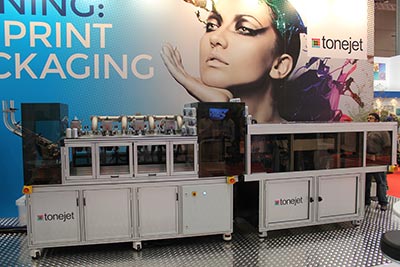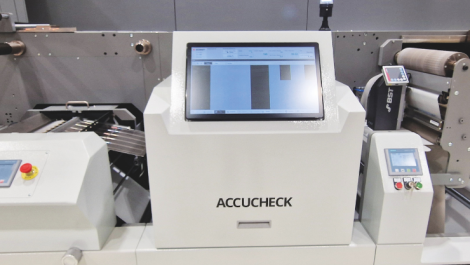Tonejet showed its can-printing expertise in Milan
The industrial print show, or InPrint to be more precise, took place at the MiCo Congressi exhibition centre in Milan on 15-17 November. Neel Madsen reports back from the event.
Following the first two editions of the event, which were held in Hannover in 2014 and Munich in 2015, the Italian show saw 2900 visitors come to meet 118 exhibitors from 13 countries. After Italy, the majority of visitors came from Germany, Switzerland, the United Kingdom, France and Spain. There were also a considerable number from further afield, including the USA, China, Russia, India, Japan, Australia, Korea, Argentina and South Africa.
Almost 65% of attendees were from the printing industry. Among those, digital (33.7%), inkjet (24.2%) and screen printing (19.8%) were the areas most represented. There was a high proportion from the manufacturing industry (26%), mainly from the textiles, plastics, electronics, mechanical engineering and automotive sectors, while 9% were from packaging. Decorative printing was the prime area of interest for 32.7% of visitors, followed by functional (31.5%), packaging printing (20.3%) and 3D printing/additive manufacturing (15.2%).
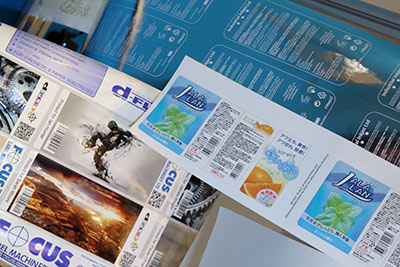
Label samples on display at the IIJ stand
Technology demonstrated
Fujifilm was focusing on its core inkjet technology by demonstrating the jetting abilities of its printheads for industrial applications across all sectors. This was complemented by examples of printed products using different types of Fujifilm inks, and information on its existing printing systems.
On show demonstrating the scalability of Fujifilm’s Samba technology was a 1.8 metre wide printbar, which can print at 1200 dpi in a single pass. This was made up of 42 printheads, each with a print width of 43 mm. The parallelogram design of the Samba nozzle plate enables simplified stitching of the heads. Print applications include commercial print, labels, packaging and textiles.
For corrugated and box printing, the company was showing its StarFire SG1024 inkjet printhead technology combined with aqueous latex inks, a system that could be installed directly as part of the filling operation in the factory.
A monochrome imprinting system using Samba printheads and UV LED Phoseon curing was overprinting labels with variable data at 150 m/min (although the system has been run at twice that speed in testing). ‘I am not aware of any other inkjet system printing at this speed at a trade show before,’ commented Fujifilm business development manager Jon Harper Smith. He continued, ‘This simple set up is focused on demonstrating the jetting capabilities that we have, but the technology itself could be used for a wide variety of applications, such as five or six colour label printing.
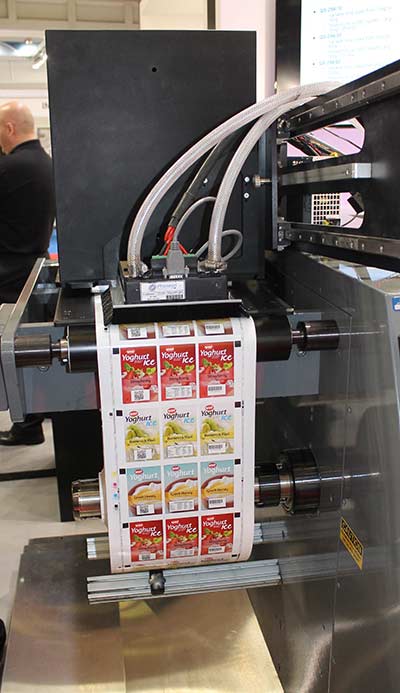
Fujifilm monochrome imprinting system
Industrial Inkjet (IIJ) shared a stand with Konica Minolta to talk to visitors about how its inkjet modules are making an impact in direct-to-object printing, packaging and security printing to name a few areas. ‘Customers come to use when they have a problem that inkjet can solve. They are looking for new efficient ways of manufacturing – and inkjet is on everybody’s list. It has become an accepted product solution,’ said managing director John Corrall.
On show, amongst many others, were label samples printed on Focus Label Machinery’s d-Flex hybrid printer and aerosol cans printed on the Michelangelo KX48P digital machine from Martinenghi, both machines incorporating IIJ technology and KM printheads.
Print and go
As promised earlier in the year, Heidelberg used the InPrint show to launch the Omnifire 1000 direct to object inkjet printer. After being officially unveiled by Jason Oliver, senior vice president, digital print solutions, and Frank Janssen, GM 4D business unit, Heidelberg, at the start of the show, the machine ran daily live demonstrations printing on hard shell suitcases.
The stand showed further printed samples, including footballs, motorcycle helmets, metal cups and plastic sports bottles. It also announced that the first installation is at Ritzi Lackiertechnik, a German company specialising in surface finishes of construction elements, such as trim strips, switches, dashboards and other finished components for various automotive manufacturers.
Gunter Ritzi, managing director, said, ‘We spent a long time searching for a solution that would allow us to meet the exacting requirements of our customers for custom decoration of passenger compartment accessories in a cost effective way in terms of quality, flexibility and cost. In Heidelberg we have found a partner that can supply us with an attractive overall package of innovative technology and matching service.’
Water jets
Sensient Imaging Technologies presented a new water-based ink developed for printing on non-porous board surfaces. Working with Italian press manufacturer Engico, this is now offered on the Aqua 250 inkjet press for corrugated board printing.
Available in CMYK, the pigmented water-based inks are marketed under the Sensijet SX platform. They have been formulated for use with piezo printheads for applications such as sign and graphics, decoration and packaging, and have achieved Nestlé compliance for food packaging.
Live production print samples from the first beta site in Italy were on show at InPrint. These demonstrated uniform ink coverage in the solid areas, high colour density and gloss levels. ‘We create a affinity between the board and the ink, without the need for priming,’ said Rudy Grosso, commercial director inks global.
He continued, ‘This increases the colour density we can achieve and also the reliability of the machine. The ink also fully retains its gloss level when printed, although this does depend on the quality of the substrate.’
On the Engico Aqua 250 corrugated press, which was first brought to market in 2013, the new inks have now removed the need for priming the substrate before printing. Sensient is working to further develop the ink for other packaging applications, including metal for food packaging, and have tested it on a wide range of other substrates.
Can it
Tonejet had a demo version of its metal can printing system running throughout the show. This included all the components of a full scale printing system and was producing 1 to 2 cans per minute (full production speed is 60-100 cans per minute). The company manufacturers its own nozzle-less printheads, which use Tonejet’s own electrostatic jetting process.
Simon Edwards, vice president sales and marketing, said, ‘The global market for can printing is huge with around 300 billions cans produced each year. Using our unique low cost technology, we can print a can for just pennies, with no minimum runs and quick turnaround. This means that you can get a new product to market in less than a week.’
Using 15 times less ink than UV inkjet, the toner-type special ink contains large pigments, which are electrically charged and jetted onto the can, leaving the carrier fluid behind. This results in a very thin ink layer of just half a micron in thickness, whilst producing a print resolution of 600 x 600 dpi in CMYK.
Mr Edwards said that the company has had a lot of interest from US craft brewers keen to exploit the opportunities to bring small brands to market cost-effectively and quickly. One production model sees mobile canning lorries come to the brewery with the cans already pre-printed. For larger operations, there is the opportunity to install the system in the factory for even more agility and shorter time to market. The company is also developing sheet and web-fed systems using the same technology.
Packaging growth
Xaar had its full range of printheads and system components on display, along with examples of applications. CEO Doug Edwards explained that packaging and product printing is the fastest growing market for the company. Coding and marking, digital label printing, direct-to-shape and product printing accounts for 20% growth annually for Xaar, and this plays a vital part in its strategy to double its size by 2020. He said, ‘Packaging is one of our four pillars and an area of great interest to us. It is a rapidly growing market that hasn’t seen a big digital transformation yet.’
Samples shown included labels printed on the Graphium press using the Xaar Print Bar System to add special effects; 3D products produced by the Factum Consortium; LCD screens manufactured by a Nakan GEN5.5 polyimide printing system; laminate samples produced on the Jupiter Digital Printing Line from Hymmen; containers printed direct-to-shape by Till, Direct Print Powered by KHS and INX Digital; and glass printed at high-volume for automotive and home appliance applications on the new Tecglass Vitro-Jet F Type/SP printer.
Seven OEMS were also showcasing technology incorporating Xaar’s printheads for a variety of applications, including Bergstein (which was showing two single-pass print systems designed to print flat and shaped industrial products), Edale, EFI Jetrion and Global Inkjet Systems.
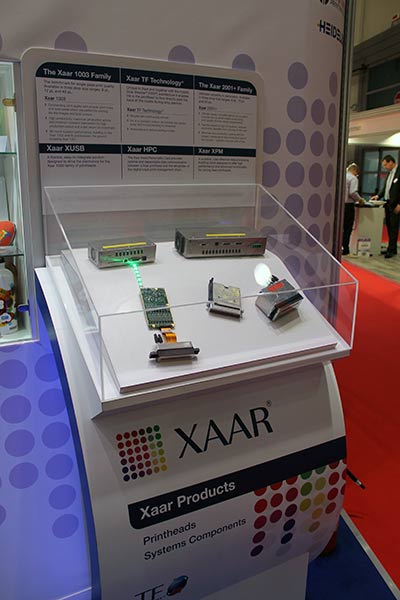
Xaar printhead technology display
Inks ahead
The SunJet inkjet division of Sun Chemical was present to highlight its products used in applications within the automotive, high technology, interior décor, metal and plastics decoration, direct-to-product, functional print and printed electronic industries.
Peter Saunders, global business director at SunJet, said, ‘As an enabler for many industrial-based applications, inkjet technology is finding itself increasingly used in, or alongside all manner of manufacturing processes, and it is this exciting future that continues to drive our commitment in the research and development of ground-breaking solutions to cater for this growing demand.’
Talking about packaging printing, Richard Hulme, global sales and product manager, said, ‘We have a lot of focus on packaging. We are extending our low migration ink range to more applications and it is now used in live production.’ The company is also further developing its EB inks for food packaging.
Nazdar Inks was present to share its expertise in inkjet technology. Established some 92 years ago, the US-headquartered company was producing mainly screen printing inks up until 10 years ago, but today 50% of volume is UV inkjet inks. The largest market is in the Asia Pacific region where some 85% of stock is sold through OEMs. Keith Nixon, sales director EMEA, said, ‘Inkjet technology is still at the early stages and the market is a huge growth opportunity for Nazdar.’
Part of this growth is in UV LED ink technology. Rich Dunklee, who has been tasked with the development and marketing of new UV inkjet products, and the product management of Nazdar’s portfolio of UV inkjet inks, said, ‘UV LED curing is a technology that has been adopted effectively. From the perspective of an ink manufacturer, we see only growth in UV LED curable inks and continue to focus a great deal of our research and development efforts in this area.’
Amica Systems showed the Taurus sheetfed UV inkjet systems adding variable data to folding cartons, printed using a Morpho Color C108P UV inkjet module, at 50 m/min in a resolution of 600 x 600 dpi. The system can be integrated into any existing press to add variable data capabilities.
The Taurus, which is sold through OEMs, uses Amica’s MagicPage VDP software to add a variety of objects, including text, dates, times, graphics and barcodes. It operates using a vacuum-based transport system and UV LED curing.
Morpho Color is suitable for web printing, sheetfed printing and both online and offline targeted marking printing. Different head modules of Morpho Color and Morpho can be combined to make a more complicated printing system for different print widths and print positions.
It was clear from the feedback from exhibitors, that this is a very focused show where a high proportion of decision-makers among the visitors come from various manufacturing industries, the industrial printing sector and traditional printing companies to network and find new working partners. John Corrall said, ‘We don’t get many tyre-kickers here. Visitors are serious buyers, who come to see the latest technology and find out how they can incorporate it into their own products and businesses.’ Richard Hulme agreed. He said, ‘it is clear that visitors come to this show with a dedicated purpose.’
InPrint Italy returns to MiCo Milano Congressi in November 2018.

